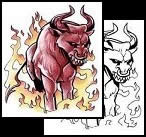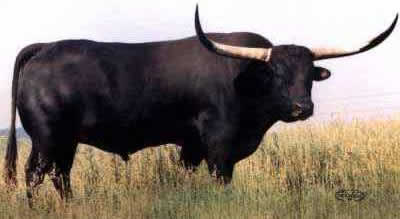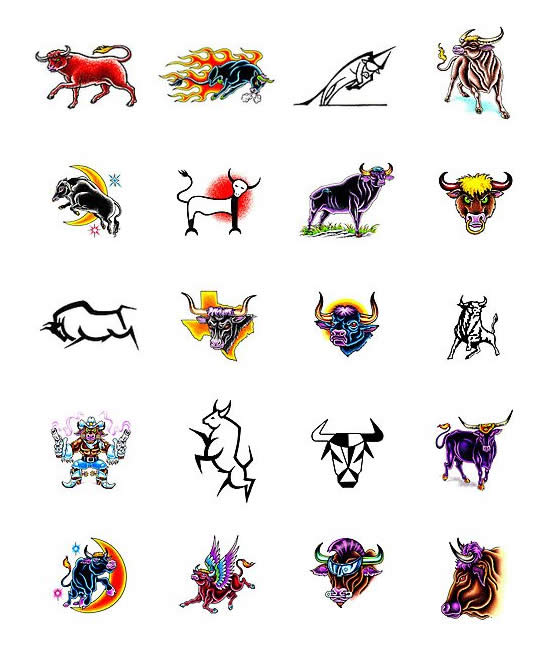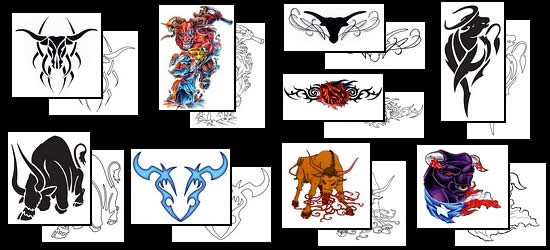|
|
|||
 |
|||
|
TATTOO DESIGNS & SYMBOLS - BULLS
Tattoo Symbol Index - A B C D E F G H I J K L M N O P Q R S T U V W X Y Z Tattoo designs - B >> Bulls
The bull's crescent shaped horns link him to moon worship and symbolism although in some areas the sun is a bull while the moon is a cow. Its association with the sun makes the Bull a symbol of the heavens, resurrection, and fire, while its association with the moon makes the Bull a symbol of earth, water, night, and death. This animal's masculinity is not diminished by its feminine lunar connections.
In Ireland a heroic warrior might be called a "bull in battle" as a compliment upon his valor and ferocity. Bulls were also emblems of tyranny, death, ferocity, stubbornness, lust, brutality, and the Devil. In symbolism the lusty bull is the antithesis of the gentle, hardworking ox.
Black bulls were associated with death in many cultures. In Egypt, Osiris' body was sometimes borne on the back of a black bull. In Indonesia and India it was customary to cremate the bodies of princes in coffins shaped like bulls.
In Hinduism, as in many other religions, the bull symbolizes strength and fertility, especially that fertility which is sparked or strengthened by fire, heat, the sun, and lightning. Its symbolism is strongly linked with that of the sacred cows of India. The cow represents the fruitful earth while the bull symbolizes the fertile sky. According to the Rig-Veda, the heavenly bull Rudra fertilized the earth with his sperm. Agni, the god of fire, was called "the mighty bull." Indra is another Hindu fertility god associated with heat and the bull. The bull-god Vrishabha was originally responsible for the spinning of the cosmic wheel. Nandi is a pure white bull which is ridden by Shiva, the Destroyer. In this case it symbolizes sexual energy which Shiva transforms into spiritual energy. Shiva's white bull also represents strength, justice, and the cosmic order. |
||
 |
|||
|
|
In some cultures it is thought that a celestial bull carries the world upon its horns. Unfortunately, this creature occasionally gets rather rowdy and tosses the globe about, catching it upon its horns. This, of course, causes violent earthquakes. In Islamic, Buddhist, and Turkish tradition bulls may carry the world upon their backs as well as upon their horns. According to Buddhist mythology the history of the earth will consist of four distinct ages. As each age passes the bull which supports the earth lifts up one of his legs. When all four ages have passed, the bull will raise his last leg and the earth will fall and be destroyed. In other parts of the world bulls are symbols of the powerful inhabitants of the netherworld.
In Greco-Roman mythology, the bull was sacred to Aphrodite/Venus, Dionysus/Bacchus, Poseidon/Neptune, and Zeus/Jupiter or Jove. In order to obtain the Golden Fleece, Jason had to yoke a pair of savage fire-breathing bulls which had been created in Hephaistos' forge and then plow a huge field with them. Zeus once masqueraded as a white bull in order to seduce Europa. The most famous bull story in Greek mythology was that of the Cretan bull and the Minotaur. According to this myth, King Minos, in order to prove that he had been divinely appointed to the Cretan throne, bragged that the gods would grant any request he made of them. He, therefore, prayed for a bull to sacrifice to Poseidon. Immediately, a beautiful white bull came forth from the sea. However, Minos decided to keep this magnificent creature and sacrificed an ordinary bull from his herds instead. Enraged by this act of ingratitude, Poseidon caused the Cretan bull to go on a rampage throughout Crete causing a great deal of destruction. Two stories are offered to explain Pasiphae's (Minos' wife's) subsequent infatuation with the Cretan bull. One says that this attraction was a continuation of Poseidon's vengeance. The other claims that Queen Pasiphae had neglected the worship of Aphrodite for a number of years. Therefore, the slighted love goddess aroused in her an unnatural desire for the beast. The queen ordered Daedalus to construct a wooden cow so that she might enter it and have sexual relations with the bull. The end result was that the queen became pregnant by the bull and delivered a man-eating monster known as the Minotaur which had the body of a man and the head of a bull. Unwilling to kill the queen's offspring, King Minos had Daedalus build the famous Labyrinth or maze underneath his castle to contain the beast. He then periodically demanded a tribute from Athens of seven youths and seven maidens (the number varies) to be sent into the Labyrinth as food for this monster. Eventually, a brave and handsome lad, Theseus, volunteered to accompany the victims being sent to the Labyrinth in the hopes of killing the Minotaur and ending the tribute. When Theseus arrived in Crete, Princess Ariadne fell in love with him and, with the help of Daedalus, came up with a plan to rescue him from the beast. Using a ball of string to leave a trail into the Labyrinth, Theseus found and killed the creature. Then, following the string, he left the maze, unchained the young Athenians, fought his way to the boats, and sailed home.
See also: Animal Tattoos Index, Nandi Tattoo Design, Taurus Tattoos Choose your own bull tattoo design from Tattoo-Art.com. Find and buy the bull tattoo design that is perfect for you. Choose your own Bull Tattoo design by the world's top tattoo artists and buy the perfect bull design for you. Tattoo designs - B >> Bulls Tattoo Symbol Index - A B C D E F G H I J K L M N O P Q R S T U V W X Y Z |
||
| Celeb Tattoos | Facts & Stats | Designs & Symbols | History | Culture | Links | Tattoo Galleries | Contact | |||
|
|
|||


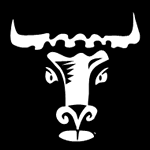
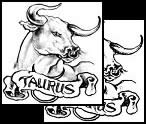
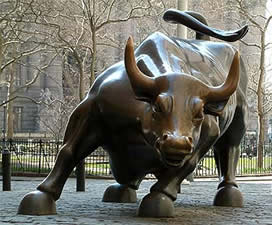 Bull cults abounded in the ancient world and survive today in
such festivities as bullfights and bull-runs. As in Ancient Crete,
where dancers leapt over the horns of bulls, these activities are
thought to praise the superiority of humans over animals and pit the
intellectual or spiritual faculties against brute force and
instinct. Oddly enough, the bull being led to the arena is sometimes
used to symbolize Christ being led to the cross. There is even a
certain movement of the bullfighter's cape called the "Veronica
Pass" which is named for the woman who wiped the blood and sweat
from Christ's face as He carried His cross to Golgotha.
Bull cults abounded in the ancient world and survive today in
such festivities as bullfights and bull-runs. As in Ancient Crete,
where dancers leapt over the horns of bulls, these activities are
thought to praise the superiority of humans over animals and pit the
intellectual or spiritual faculties against brute force and
instinct. Oddly enough, the bull being led to the arena is sometimes
used to symbolize Christ being led to the cross. There is even a
certain movement of the bullfighter's cape called the "Veronica
Pass" which is named for the woman who wiped the blood and sweat
from Christ's face as He carried His cross to Golgotha.